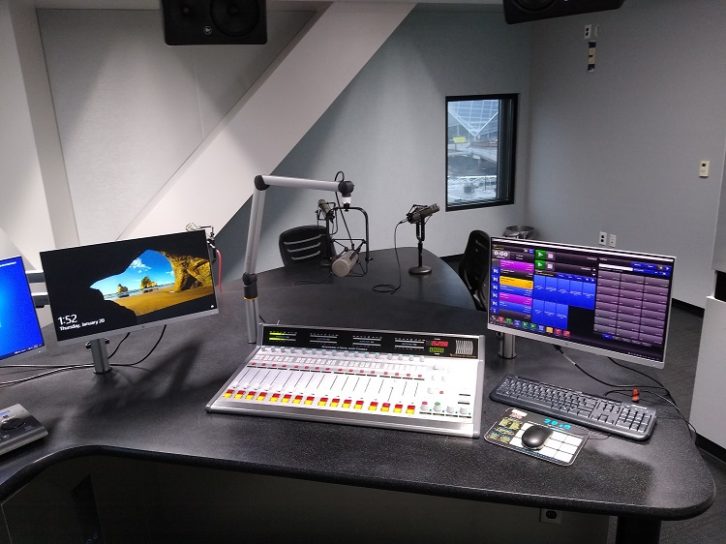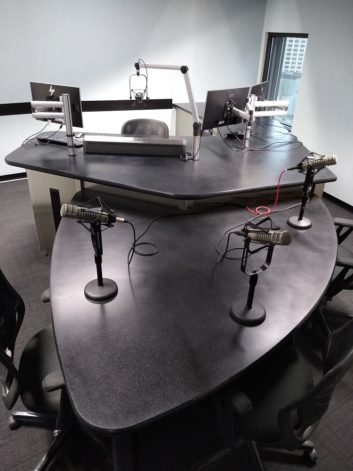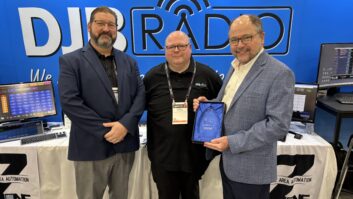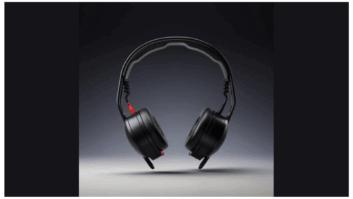
A version of this story appeared in the Radio World ebook “Spectacular Radio Studios.”
A new studio is serving Urban One’s office in Atlanta.
The company’s Radio One and Reach Media arms have operations there, and this studio will be used by Atlanta-based members of “The Rickey Smiley Morning Show,” which has its main studio in Dallas. The room will also serve as the main origination studio for “The Willie Moore Jr. Show” and “The Nightly Spirit.”
“This was a single-studio buildout, but not a small project,” said Radio One Atlanta’s Chief Engineer Vic Jester, who was network lead on the project. Physical construction and design were done by Warren-Hanks Construction and McAfee3 Architects. Integration was principally by Bohn Broadcast Services, which sent Paul Burt and Micah Dempsey as on-site engineers for the job.
“We utilized space that had been a temporary production studio and adjacent show prep area. We completely removed all existing partition walls, floor and ceilings,” Jester said.
“We then constructed new double-stud interior walls with double drywall layers on both sides, a new outer sound isolation wall inside the existing building’s exterior wall, and a new hard ceiling, spring-suspended from the overhead, for isolation from the floor above.”
The team then installed sound absorption insulation fabric to the interior wall surfaces to match Urban One’s existing suite of studios. “We’re on the 12th floor of a downtown high-rise building, so excellent sound isolation is required from street noise and adjacent tenants.”
[Related: “WABC Lobby Offers a Nod to History”]
One transition in evidence here is the move to audio over IP.
“Our facilities were constructed when AoIP was on the horizon but not yet a viable option. Our core router and studio worksurfaces are all TDM-based. We are in the processing of transitioning to WheatNet IP-based audio routing but are not quite at the point where we can completely move to that.”
So they chose to repurpose a Wheatstone G-4 digital work surface and satellite frame inherited from the purchase of a station and integrated it into the existing router system.
“It’s a testament to Wheatstone that they are still able and willing to support 16-year-old infrastructure in this respect. The new studio isn’t completely TDM-based, as we do have WheatNet IP-based Blades in the studio for microphone processing and control functions.”
 Key elements also included WideOrbit Automation for Radio, and VoxPro and Adobe Audition for audio editing. The team repurposed its EV RE30 microphones, Stanton dual CD deck and Mackie HR824mk2 powered monitor speakers. They purchased new Yellowtec monitor and mic arms as well as a new Wheatnet M4 Mic processor.
Key elements also included WideOrbit Automation for Radio, and VoxPro and Adobe Audition for audio editing. The team repurposed its EV RE30 microphones, Stanton dual CD deck and Mackie HR824mk2 powered monitor speakers. They purchased new Yellowtec monitor and mic arms as well as a new Wheatnet M4 Mic processor.
Custom cabinetry was by Studio Technologies, whose owner Vince Fiola drove to Atlanta from Philadelphia to deliver.
Jester said the project includes installation of studio lighting and cameras to provide video for the web division. “My former Assistant CE Jason Staten, who now works as an independent movie lighting technician, has been the lead designer of that component.”
Jester noted that many radio broadcasters are in a time of transition in how they manage such projects.
“Some companies are considering how to scale back on office space. Some are in the process of downsizing every part of their operations. In this case Urban One is investing in studio space and creating an environment to allow network operations to expand. It provides a space where air talent and producers can collaborate in person, thus offering a better product to affiliates. Reach Media Radio Division CEO David Kantor, Atlanta VP/GM Tim Davies and VP of Engineering John Soller were willing to invest in the infrastructure here, particularly when many other companies are reducing or eliminating their ability to produce content.”







